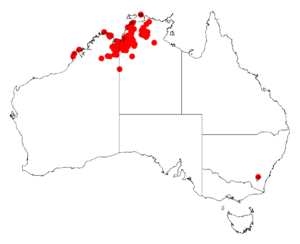Acacia pellita facts for kids
Quick facts for kids Acacia pellita |
|
|---|---|
| Scientific classification | |
| Genus: |
Acacia
|
| Species: |
pellita
|
 |
|
| Occurrence data from AVH | |
Acacia pellita is a special kind of shrub or tree. It belongs to a big group of plants called Acacia, also known as wattles. This plant is found only in certain warm, northern parts of Australia. It's a unique plant that grows naturally in those areas.
Contents
What Acacia pellita Looks Like
This shrub or tree usually grows to be about 3 to 6 meters (10 to 20 feet) tall. It has bark that is grey or brown and feels a bit stringy. Its branches are slightly angled and covered in soft, woolly hairs.
Leaves and Flowers
Like most Acacia plants, Acacia pellita doesn't have regular leaves. Instead, it has what are called phyllodes. These are flattened leaf stems that act like leaves. They stay green all year round.
- The phyllodes are long and narrow, shaped like an oval.
- They are about 10.5 to 19.5 centimeters (4 to 7.5 inches) long.
- They are 30 to 100 millimeters (1 to 4 inches) wide.
- Each phyllode has two to four clear veins running through it.
Acacia pellita blooms with yellow flowers from May to August. The flowers grow in cylinder-shaped spikes. These spikes are 3 to 7 centimeters (1 to 3 inches) long and are full of bright golden flowers.
Seed Pods
After the flowers bloom, fuzzy seed pods start to grow. These pods are tightly coiled up. They are about 7 centimeters (2.7 inches) long and 3.5 to 5 millimeters (0.1 to 0.2 inches) wide. Inside, you'll find black, oblong-shaped seeds. Each seed is about 3.9 to 4.5 millimeters long.
Where Acacia pellita Grows
This plant is found naturally in a large area of northern Australia. You can see it in the Northern Territory and the Kimberley region of Western Australia.
Preferred Environment
Acacia pellita likes to grow in sandy or loamy soils. It prefers places that are a bit damp. You can often find it along the banks of creeks. It grows as part of Eucalyptus woodlands, which are forests mainly made up of eucalyptus trees. It often likes shady spots, especially on or near sandstone or laterite rock formations.

